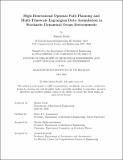High-Dimensional Optimal Path Planning and Multi-Timescale Lagrangian Data Assimilation in Stochastic Dynamical Ocean Environments
Author(s)
Doshi, Manan
DownloadThesis PDF (27.37Mb)
Advisor
Lermusiaux, Pierre F. J.
Terms of use
Metadata
Show full item recordAbstract
In the ocean domain, opportunities for a paradigm shift in the science of autonomy involve fundamental theory, rigorous methods, and efficient computations for autonomous systems that collect information, learn, collaborate and make decisions under uncertainty, all in optimal integrated fashion and over long duration, persistently adapting to and sustainably utilizing the ocean environment. The ocean is a prime example of multiscale nonlinear multidisciplinary and strongly coupled dynamics where measurements of one variable can be used to infer other fields through their joint dynamic probability density functions. Integrating ocean dynamics with autonomy enables the principled exploration, sustainable utilization, and strong conservation of our oceans. The object of this thesis is to develop theory, algorithms, and computational systems for the high dimensional optimal path planning of autonomous vehicles in the physical space augmented with other dynamical fields, and for the Bayesian nonlinear assimilation of the observations gathered by these vehicles along their trajectory. The resulting high dimensional optimal path planning and generalized Lagrangian Bayesian data assimilation enable the sustained and optimal operation of autonomous vehicles over a long time duration in realistic uncertain ocean settings. With this vision, the vehicles autonomously make decisions to optimally achieve their mission targets in the augmented space of physical and collectible fields, e.g., reach the destination in minimum time while using the minimum energy, harvest the maximum wave-solar-wind energy, or farm the maximum amount of kelp.
To this end, we focus on three specific theoretical and methodological goals: (i) Develop exact differential equations and accurate algorithms to efficiently predict and compute the reachable sets and optimal controls for complex high-dimensional objectives in dynamical fields and showcase these controls in realistic ocean scenarios; (ii) Develop Bayesian theory and schemes to predict Lagrangian field probability densities and rigorously assimilate Lagrangian data collected by moving vehicles or drifters, leveraging the different sensitivity and timescales of the underlying Lagrangian and Eulerian systems; and (iii) Integrate the optimal planning and assimilation to enable learning from the information gathered on-board the vehicles, from Bayesian updates of the optimal controls to the acquisition of knowledge using Bayesian learning. We showcase the theory and methods in a range of ocean applications.
In the first part, we review the theory and schemes to predict joint energy-time, harvesting-time, and energy-harvesting-time reachability fronts and optimal paths using state augmentation. %extending to high dimensional coupled fields the theory and schemes for solely time-optimal path planning. We validate our energy-time algorithms in analytical and representative dynamical fields. We then derive theory to predict reachability fronts across multiple times simultaneously and obtain a closed loop control law allowing vehicles to accomplish their mission even after straying from their initial plan due to forecast errors. The theory and schemes are developed for both backward and forward reachable tubes with time-varying target and start sets. The resulting value functions elegantly capture not only the reachable tubes but also time-to-reach and time-to-leave maps as well as start time versus duration maps. We validate results with analytical solutions and demonstrate wider applications for optimal control in dynamic environments.
In the second part, we develop and implement fundamental schemes for multi-timescale Bayesian data assimilation for coupled dynamical systems, with a focus on Lagrangian-Eulerian systems. We obtain a Gaussian Mixture Model (GMM) - Dynamically Orthogonal (DO) based hybrid filter for Lagrangian and Eulerian stochastic fields and observations. We first showcase the schemes for a coupled system where we analytically validate the performance of the filter. We subsequently demonstrate results by applying the filter for a general coupled chaotic system and for a joint Lagrangian-Eulerian system with a more complex quasi-geostrophic flow.
In the third part, we integrate the schemes developed for the first two parts. We propose coupled methods that allow ocean vehicles to robustly and optimally complete their mission while continuously learning from the new information being collected, updating the Lagrangian and Eulerian fields, their joint probabilities, and the robust optimal control of their future trajectories. We showcase preliminary results using the proposed method.
We conclude by demonstrating several planning and Lagrangian algorithms in data-assimilative ocean simulations and real-time ocean experiments with real data and forecasts. This includes the characterization of residence times and connectivity in the Red Sea, the transport of plastics in the coastal ocean showcasing results for Massachusetts Bay, the subduction pathways of surface waters to intermediate depths in the Alboran Sea, and the Bayesian Eulerian-Lagrangian data assimilation of drifter data in the Balearic Sea.
Date issued
2024-05Department
Massachusetts Institute of Technology. Department of Mechanical EngineeringPublisher
Massachusetts Institute of Technology